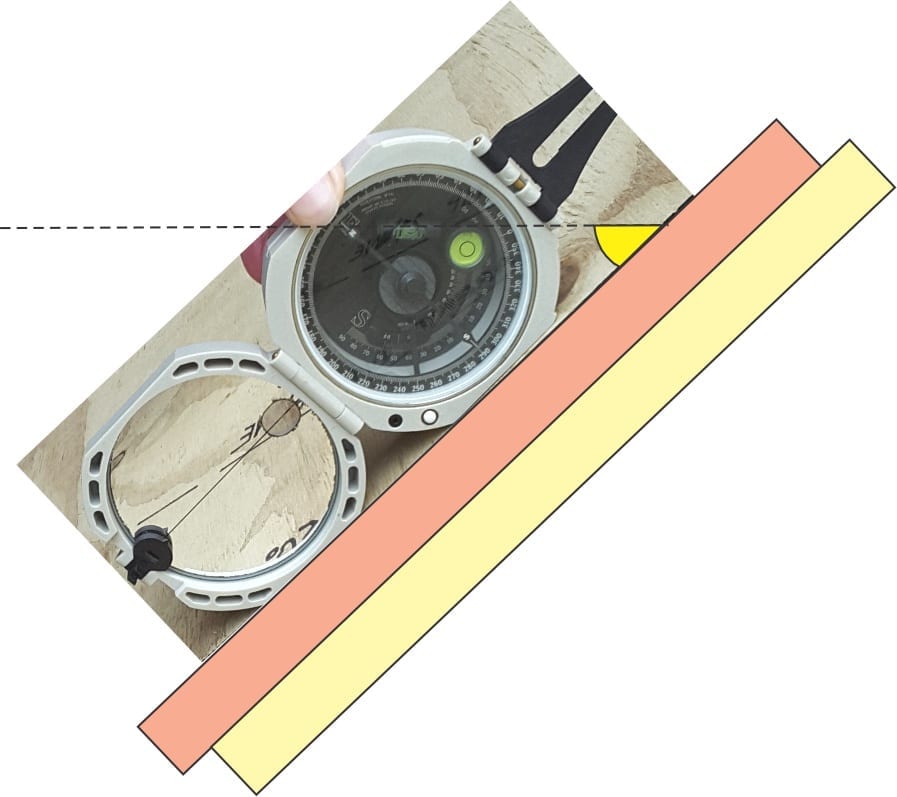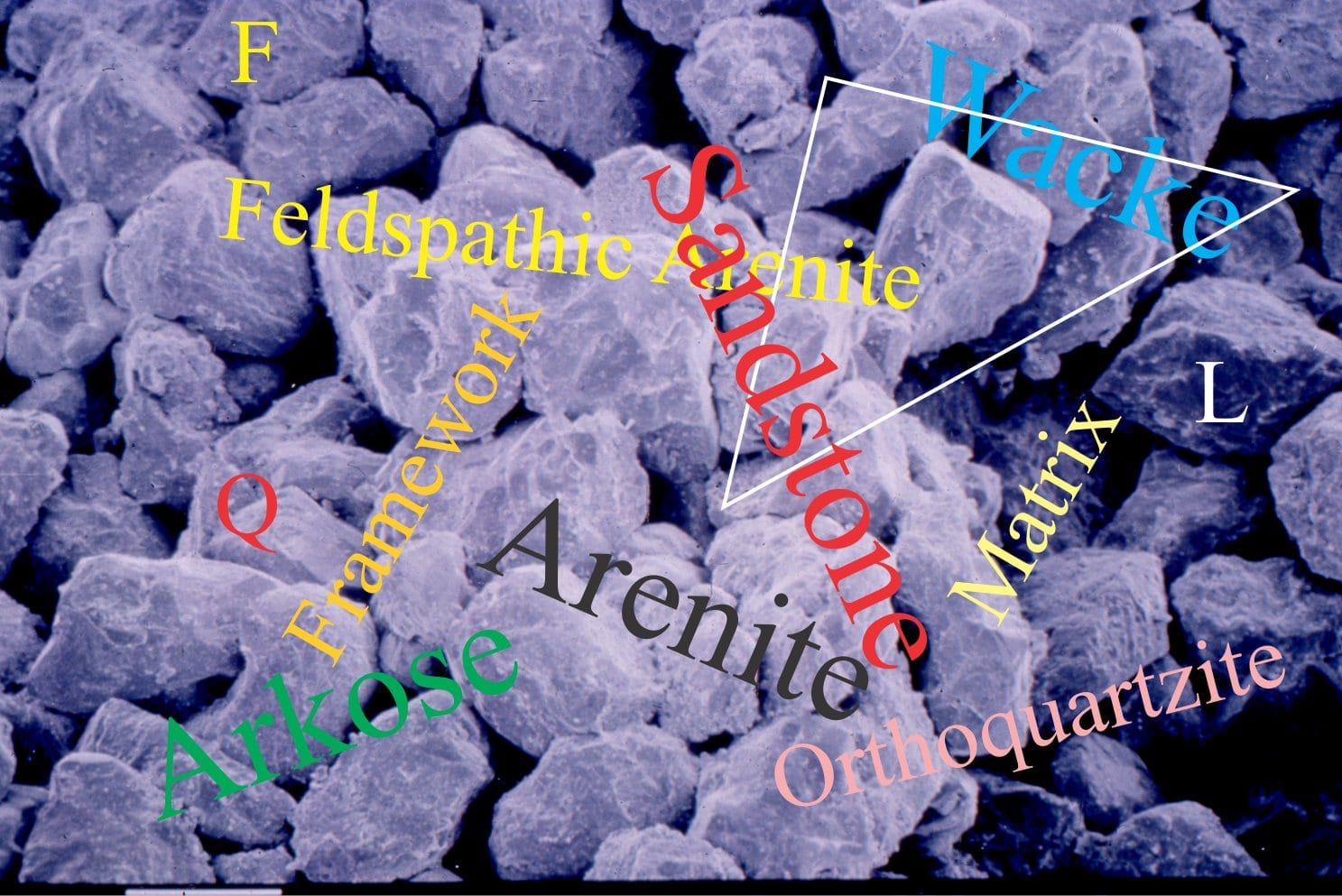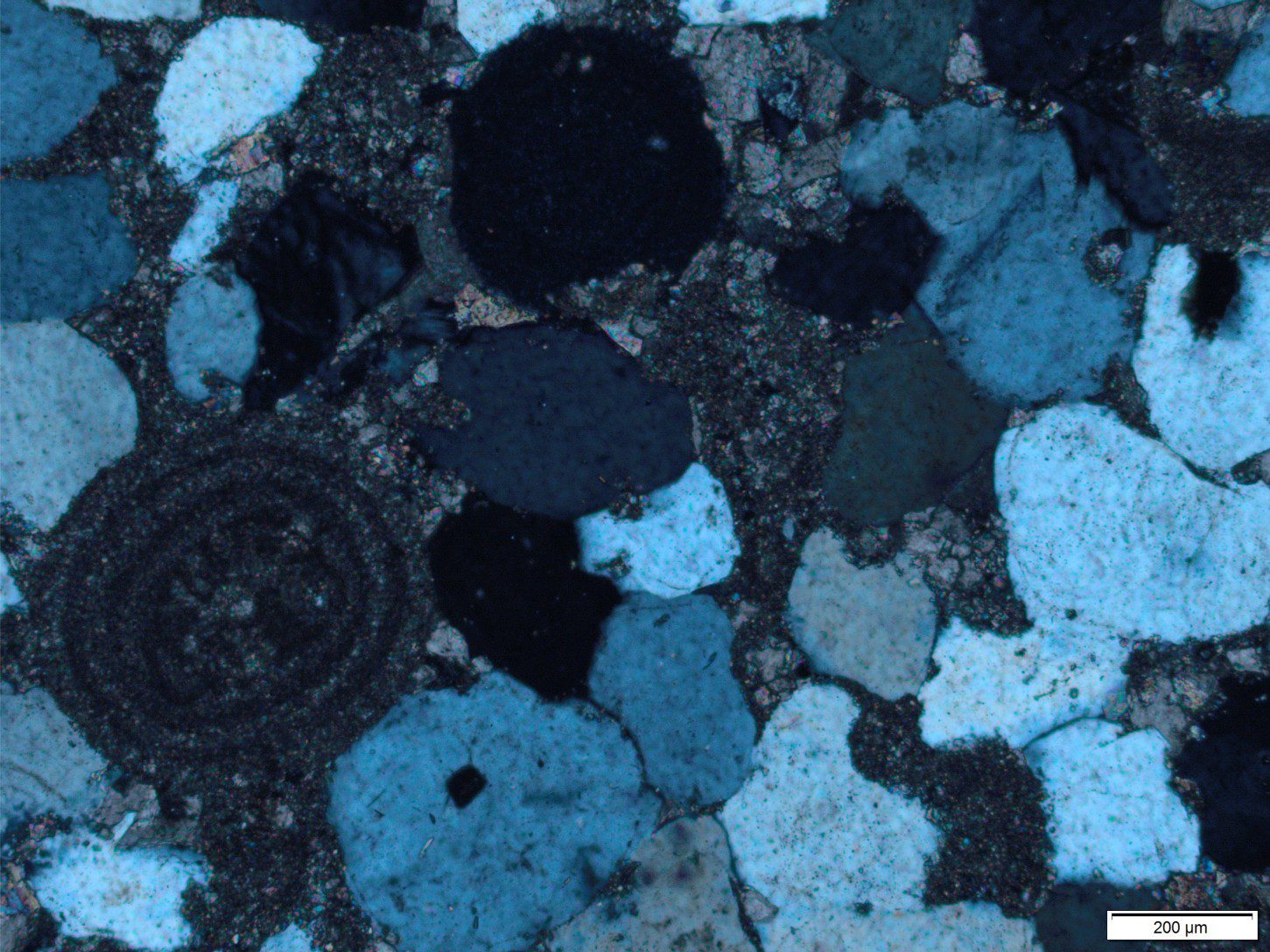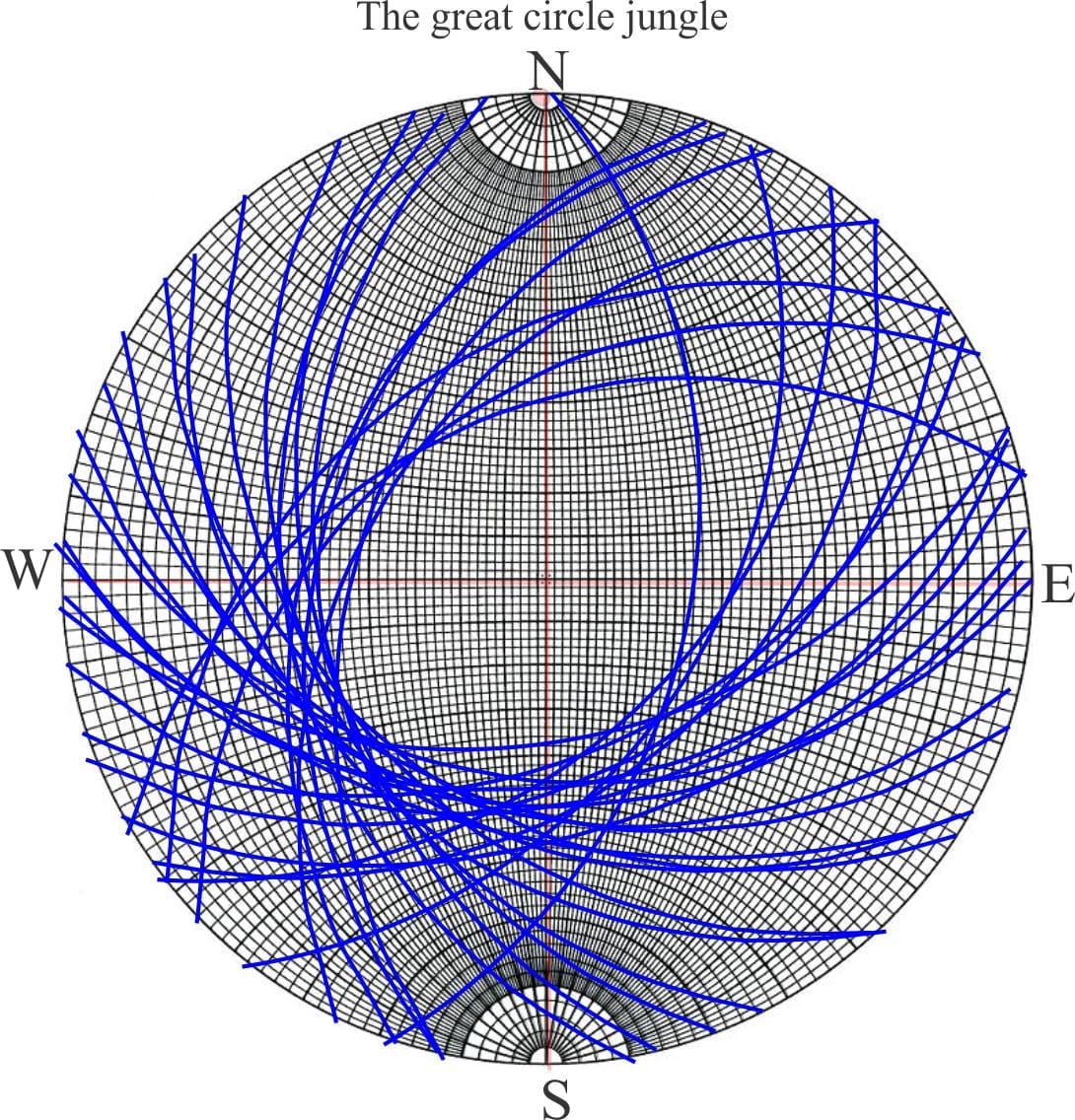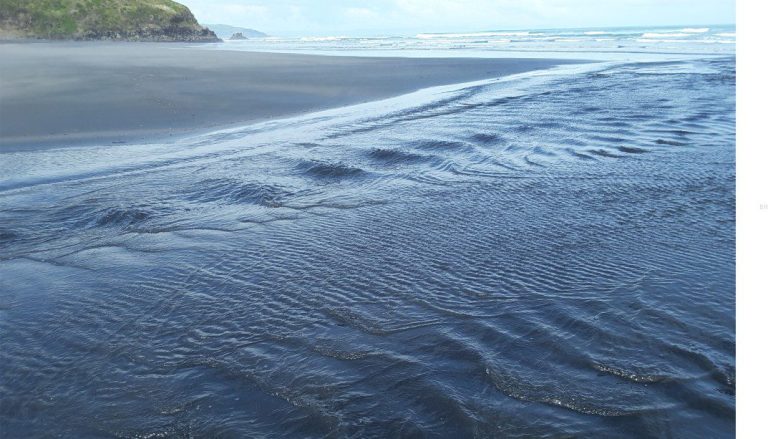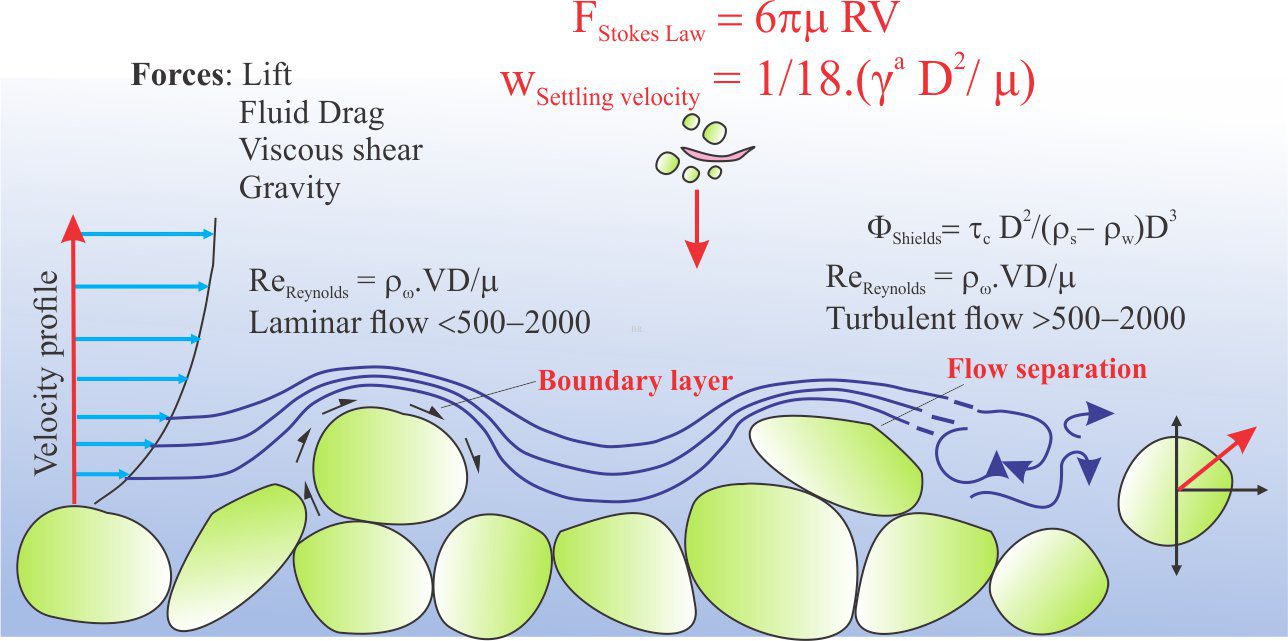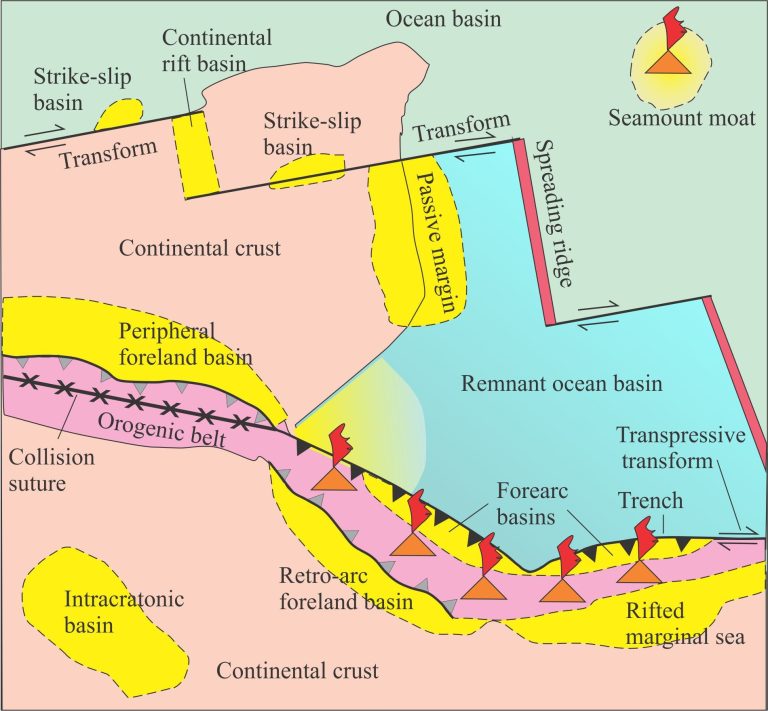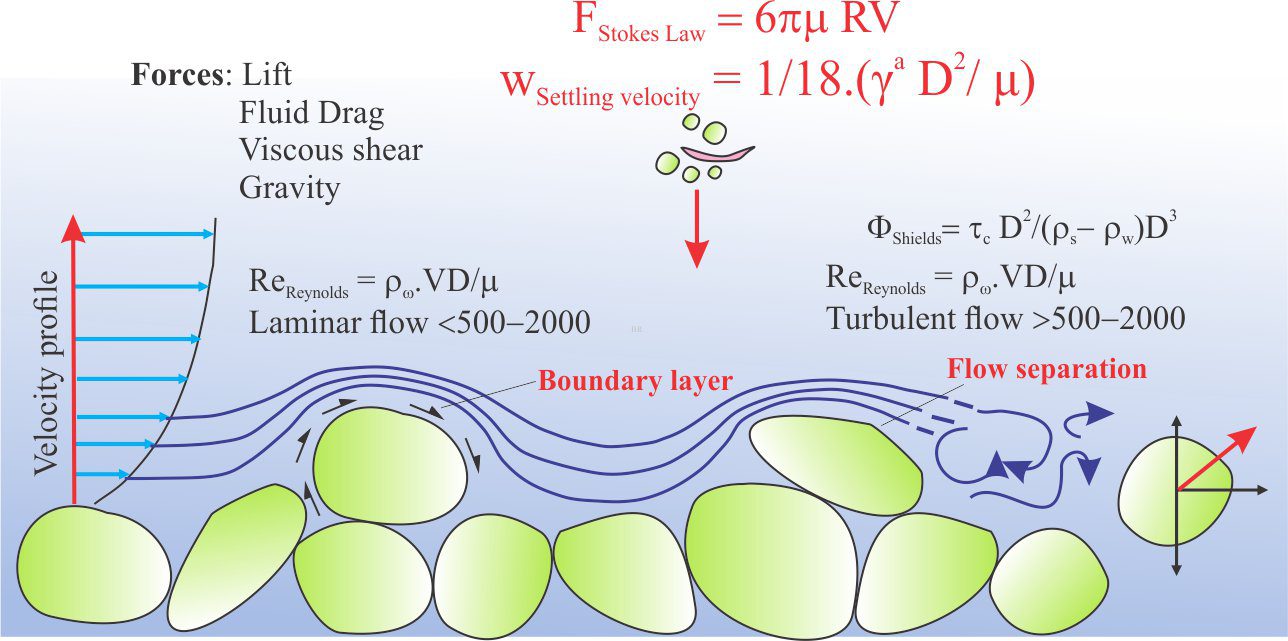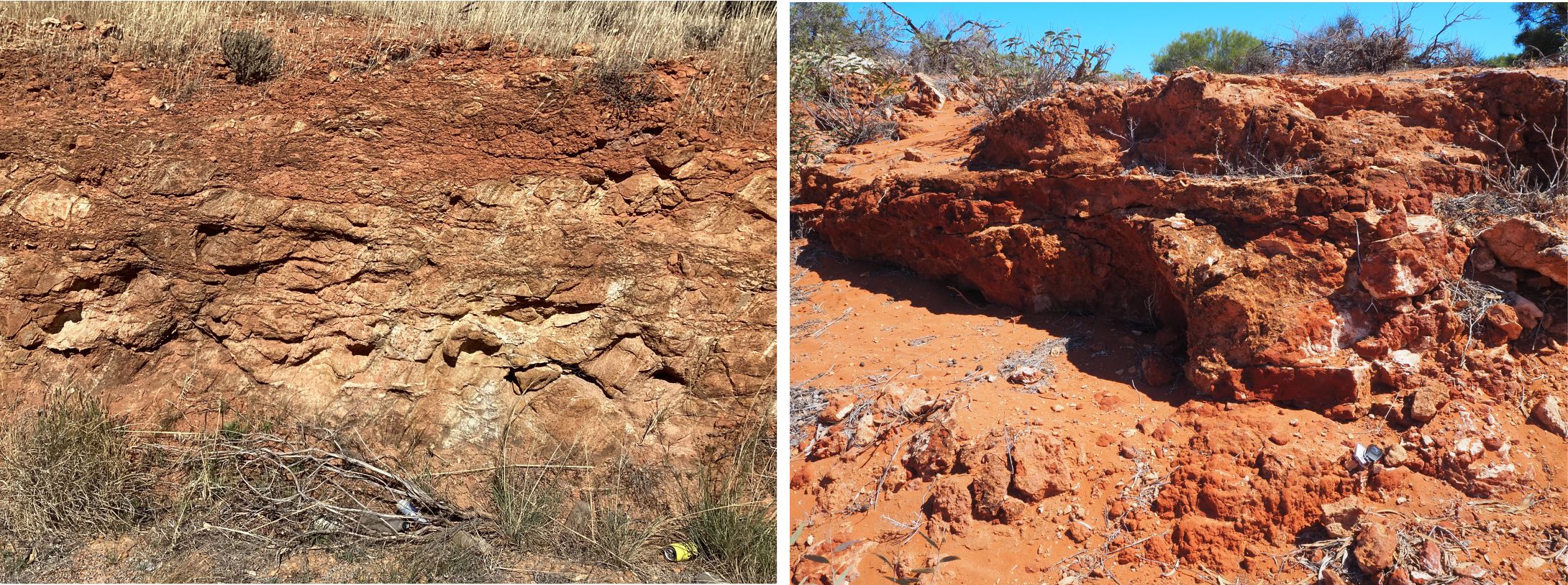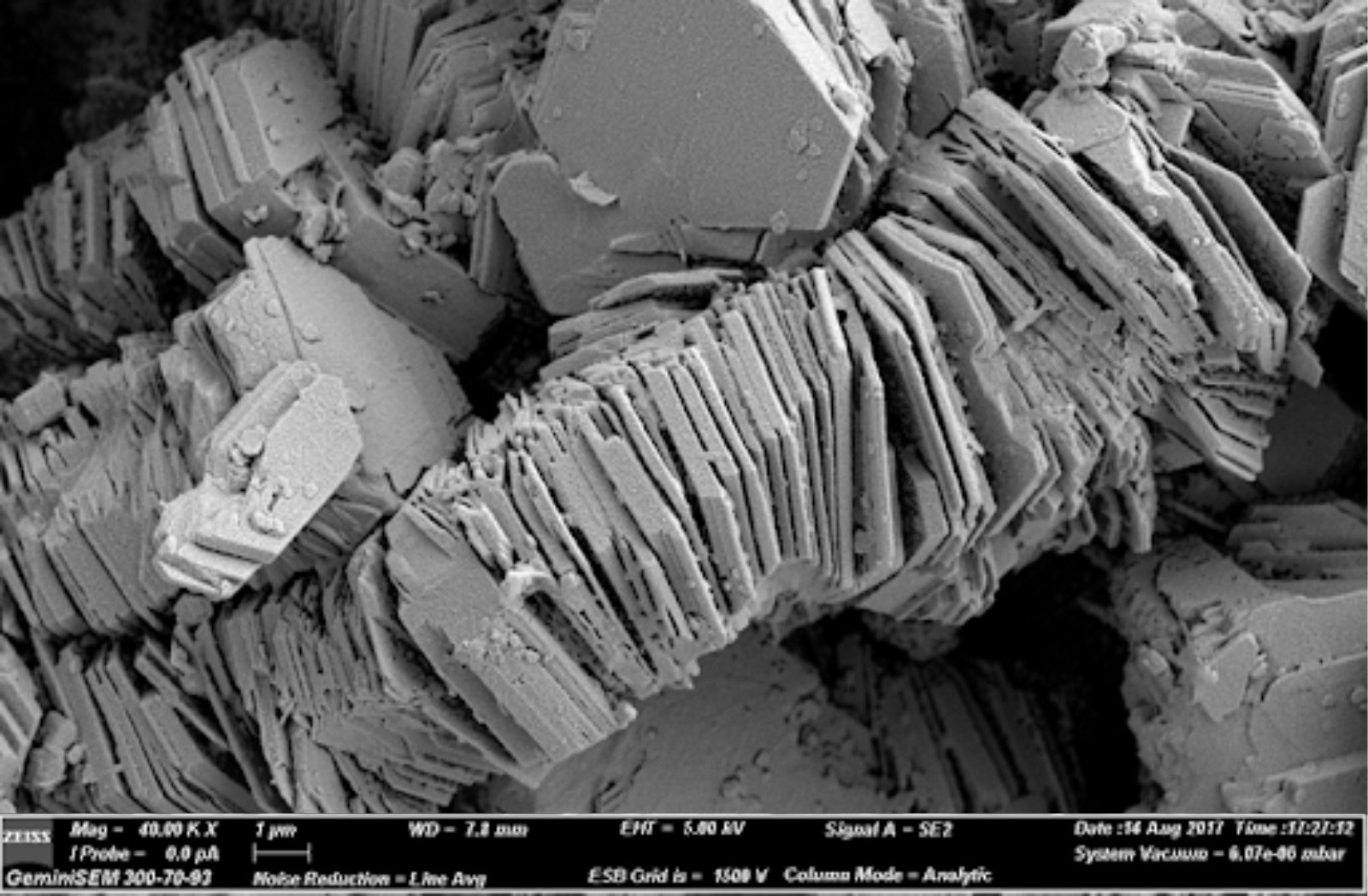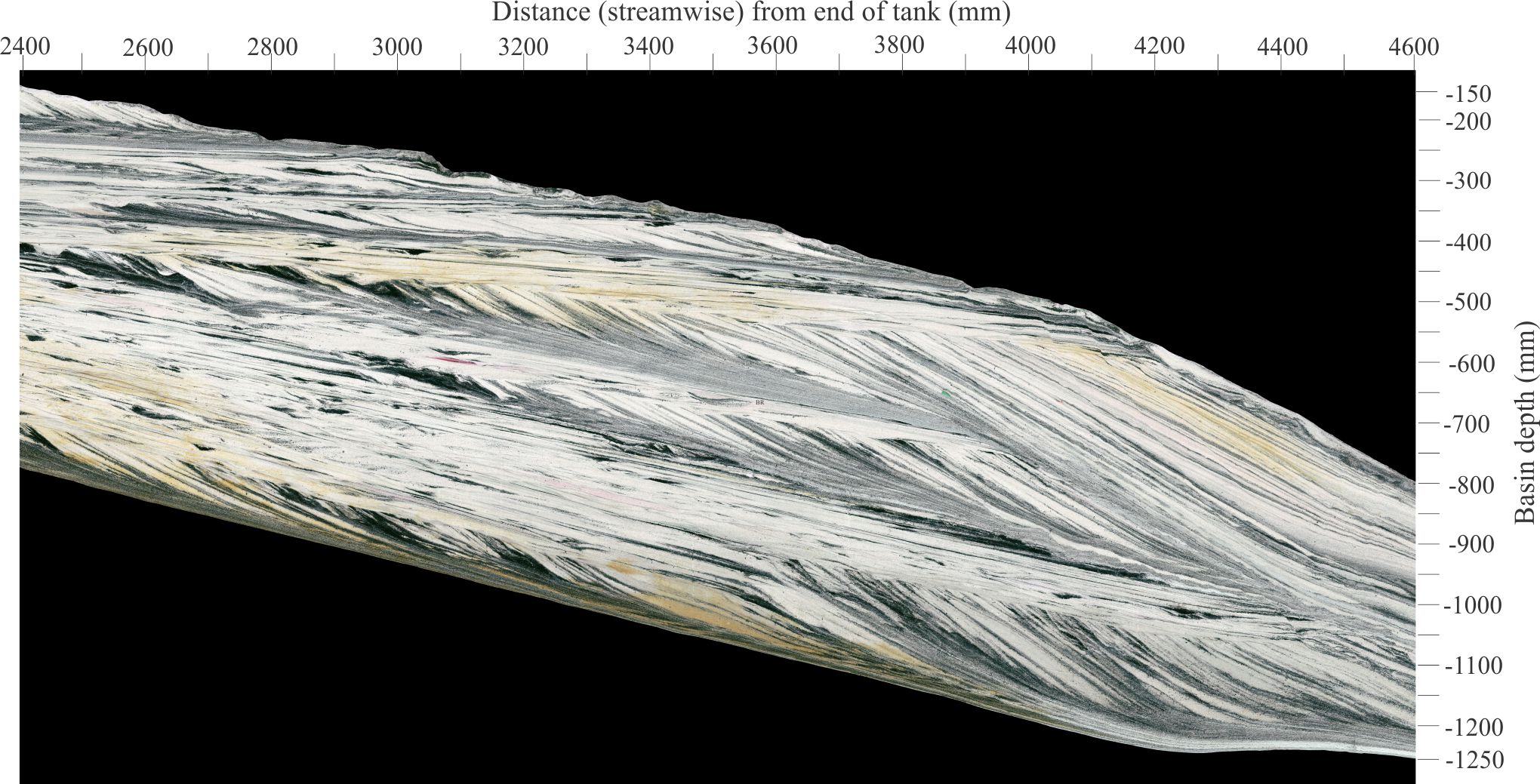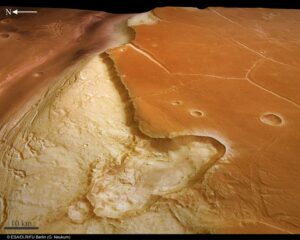
The rocky planets – Mercury, Venus, Earth (its Moon), and Mars
Our knowledge and understanding of the Solar System and its manifold flotsam and jetsam, from specks of dust to our average-sized Sun, has increased to the point that travel by spacecraft and rovers to far-flung lands is not only achievable, it allows us to contemplate our own sojourns – to Mars or back to the Moon. I marvel at the bewildering differences among our planets – the rocky planets and gas giants and their tidally-trapped partners; Io, Enceladus, Titan, the Moon. My own visits to any of these will only ever be imagined.
Any attempt to unravel the geological history of planetary bodies, particularly the rocky planets, inevitably begins with our Earth-bound systems and processes – the acceptance that the laws of thermodynamics and gravity apply anywhere in the universe, and therefore, that the principles of stratigraphy also apply. When we envisage the geological history of the Moon or planets, we are invoking these fundamental principles.
The charts that follow attempt to outline the geological history of the inner Solar System rocky planets. The histories are based on established principles of scientific interpretation and the stratigraphic accounting for the time and space relationships among planetary materials and structures – Nicolas Steno’s superposition, and the Huttonian principle that an examination of modern processes and systems will guide our understanding of the geological past.
There is a burgeoning literature dealing with planetary science. Refer to the papers cited here for more encyclopedic reference lists.
Accounting for geological age
Relative dating of stratigraphic units on Earth is based on superposition and the evolutionary progression of fossils. Radiometric dating allows us to quantify these ages. The strategy for relative dating on the other rocky planets is based solely on the superposition of morphological units (map units such as basins, rocky highlands, impact craters). Rock stratigraphic and chronostratigraphic frameworks for Mars, Venus, and Mercury have been established using models of crater densities. The underlying principles for this ‘crater counting’ method are that older terrains will have greater numbers of craters, and that older craters will be more degraded than younger craters (Hartmann, and Neukum, 2001; Tanaka and Hartmann, 2012; Ivanov, 2001; Werner and Tanaka, 2011. The Moon is the “type planetary body” for this dating method. (See the post Martian Stratigraphy – the framework). The model chronology for the Moon has been calibrated using radiometric dates of samples returned from the Apollo, Luna, and Chang’e missions. Calibration of Martian chronology is based on dating of meteorites, ejected from Mars’ surface and subsequently captured by Earth.
Chronostratigraphic chart for the rocky planets
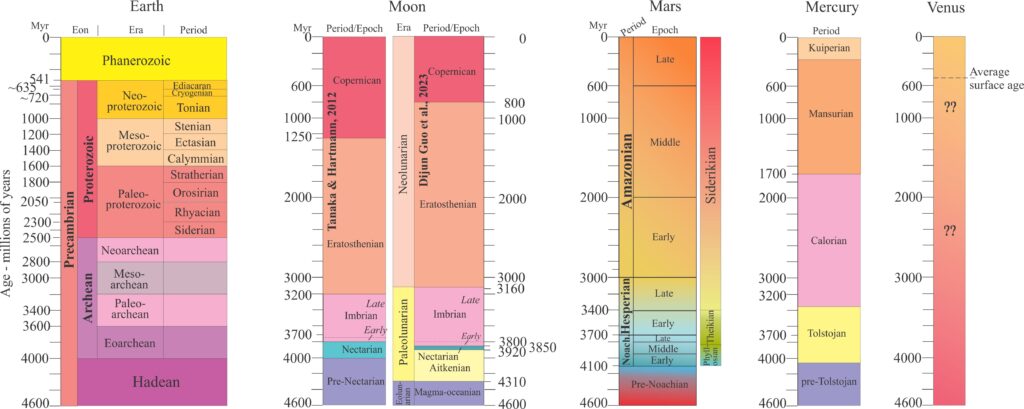
The chart compares the chronostratigraphy (time-stratigraphy) of all the rocky planets. The generalized geological history of each planet plus the Moon is shown in separate panels below. Emphasis is given to events that have shaped each planet. All the planets began in much the same way –accretion from a solar nebula about 4.6 Ga, cooling and differentiation of a core (mostly still molten), mantle, and crust within the first 200 to 300 million years. From this point on, their evolution diverged. Chronostratigraphic units for Mars, Mercury, and the Moon have Period and Epoch rank. Equivalent ranked periods on Earth include Permian, Cretaceous etc. Gao et al., (2023) revised the lunar period/epoch ages, placing them in three Eras within a single Eon – the Lunarian. The starting point for all these comparisons is Earth – the chronostratigraphic framework is from the International Stratigraphic Commission, 2023.
Earth
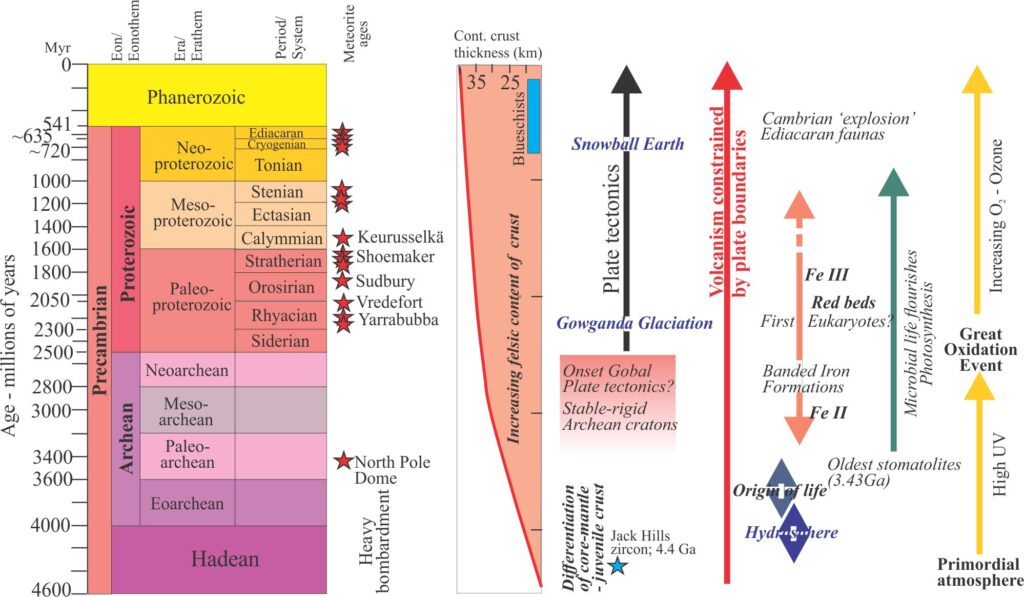
Global magmatic differentiation on Earth advanced much further than any other planet. Solidification of crust was well underway by about 4.4Ga (Jack Hills zircons; Bowring, 2014). The formation of relatively coherent cratonic blocks, or terranes as mobile lids on the mantle also appears to have progressed by the end of the Archean with some form of plate tectonics becoming active by early Proterozoic. Coincidentally, cratonic magmas became increasingly felsic (Hawkesworth et al.,2024; OA). Plate tectonics continued to ‘mature’ throughout the Proterozoic and Phanerozoic.
Differentiation of volatiles into a hydrosphere and atmosphere was possible once the crust had cooled sufficiently. However, unlike Mars, both spheres have survived, partly because of Earth’s stronger gravity, but more fundamentally because of the survival of Earth’s geomagnetic field – the dynamo-effect of a rotating inner core. Rotation of the inner core may have begun during or soon after its separation from the outer core and mantle. Rotation has continued relatively unabated. The continuance of the magnetic field has prevented the stripping of all but the lightest components of the atmosphere (e.g., H2 and He2 did not survive).
The origin of life was inextricably linked to the evolution of the crust, atmosphere, and hydrosphere. The explosion of prokaryotic cryptalgal laminates (stromatolites) in the late Archean and Paleoproterozoic, banded iron formations that operated as oxygen sinks (Konhauser et al., 2017), the Great Oxidation Event (GOE), the earliest Snowball Earth (Gowganda Glaciation), and the appearance of red beds, all signal remarkable changes to Earth’s skinny outer layers. The primary source of molecular oxygen was microbial photosynthesis. The oldest eukaryotes also appeared around the two billion year mark, but it took another billion years and an additional snowball Earth for evolution to advance to more complex life forms in the Ediacaran (635–538 Ma).
Moon
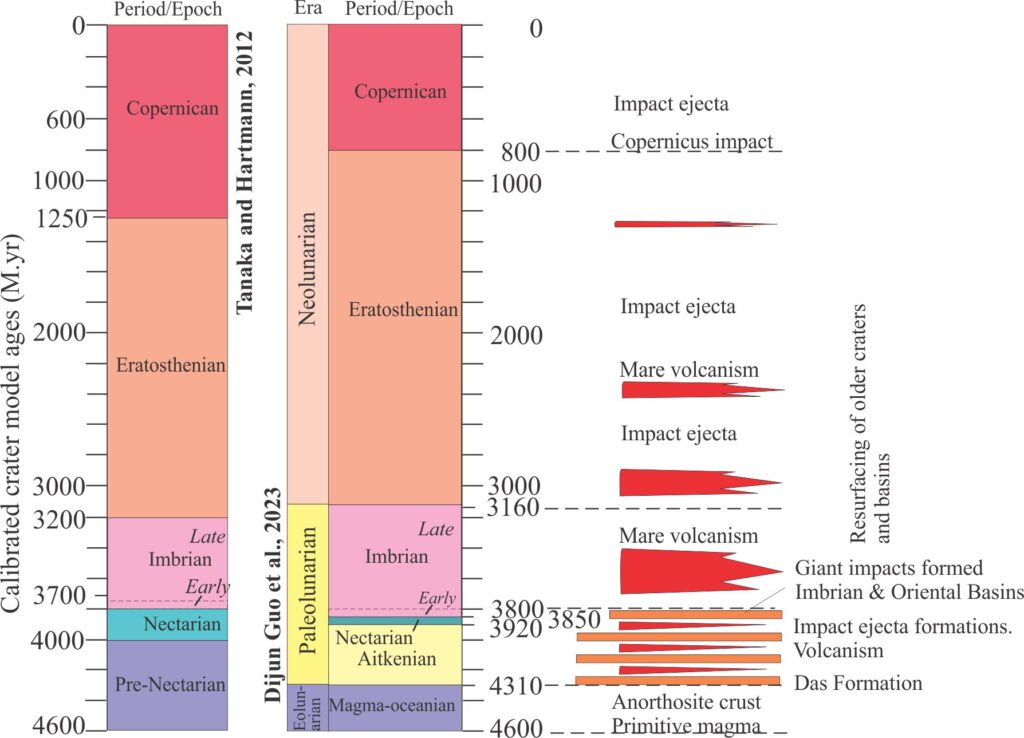
The lunar time-stratigraphic and chronostratigraphic frameworks are based on crater densities calibrated with radiometric age dates. There are five periods, the boundaries of which are defined by major impacts, for example the base of the Nectarian Period is Nectaris Basin. The Imbrian Period is defined by the Imbrian Basin, one of the largest impact structures known at more than 1000 km diameter, that probably formed during the period of heavy bombardment. Older units tend to be saturated with craters. The model ages have undergone several iterations (e.g., Tanaka and Hartmann, 2012; Werner et al, 2023, PDF). Significant modification to the pre-Imbrian stratigraphy by Guo et al., (2023) was based on detailed mapping of ejecta blankets and mare volcanism. The new Aitkenian Period/System is based on these stratigraphic relationships in the South Pole-Aitken Basin.
Mars
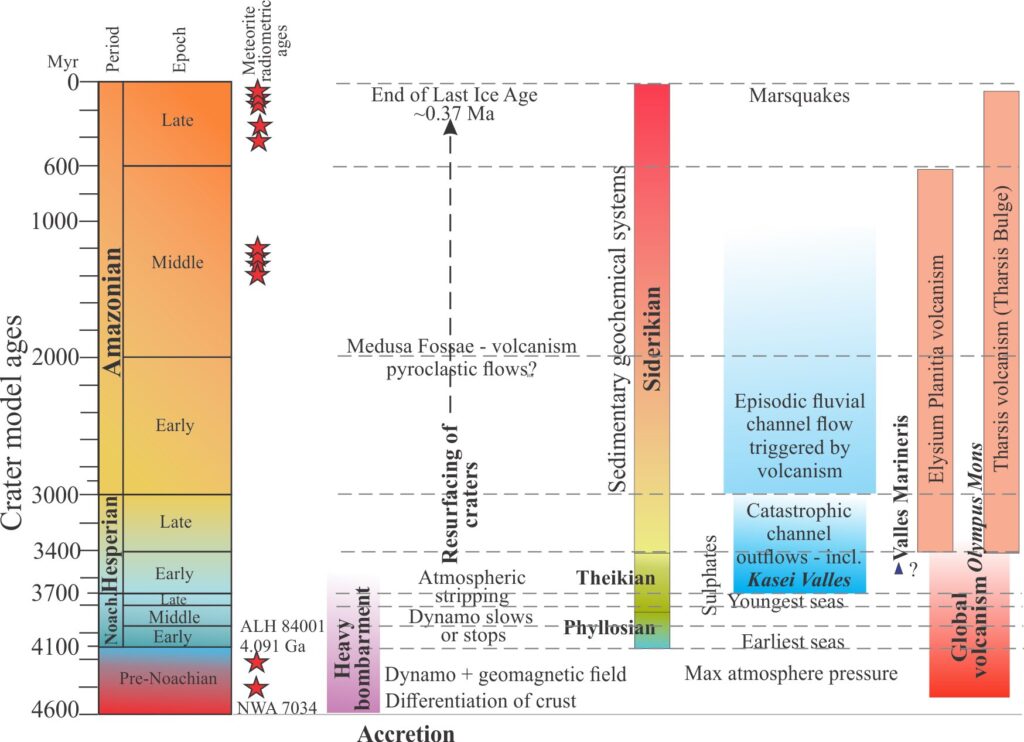
Like Earth, the first half billion years records significant differentiation and partial melting of its accretionary sphere into solid crust. Cooling had progressed to the point where liquid water could accumulate in shallow lakes, seas, and as groundwater. However, unlike Earth its geomagnetic dynamo either slowed or ceased to rotate by about the billion-year mark, initiating atmospheric stripping by intense solar winds. Lower atmospheric pressures (mostly CO2, N2, and water vapour) would have shifted the stability of liquid phase water – Mars surface history from about the end of the Noachian (3.7 Ga) was dominated by intense desiccation.
The first billion years on Mars bore witness to widespread sedimentation. Erosion, sediment production, dispersal, and deposition contributed to the resurfacing of Mars craters:
- granular, siliciclastic sediment produced by physical and chemical weathering of bedrock, mass wasting, and impact ejecta. Images from Martian rovers suggest deposition in river channels, lakes, deltas, plus aeolian deposits (e.g., Grotzinger et al., 2011; Grotzinger and Milliken, 2012; Heydari et al., 2023).
- Chemical sediments derived from solute produced during weathering of bedrock. In older rocks, clay-rich silicates and sulphates are the most common types; anhydrous iron-rich sediments were more prominent during the Amazonian. The informal stratigraphic designations Phyllosilian, Theikian, and Siderikian refer to these dominant types over time. The presence of siderite in some rocks indicates that the carbonate cycle was also linked to Noachian – Early Hesperian atmosphere-hydrosphere and water-rock interactions (Tutolo et al., 2025).
- Sedimentation appears to have been increasingly sporadic and localized from Mid- to Late Hesperian through Amazonian, notably as channelized fluvial or lake outbursts, commonly catastrophic. Melting permafrost in regions of volcanic activity may have contributed to the release of large volumes of water (notably the Elysium and Tharsis regions). The largest outburst channel complex is Kasei Valles, 3500 km long and up to 2.5 km deep.
The last three billion years were dominated by continued atmospheric stripping and desiccation, that is manifested as widespread formation of anhydrous iron oxides. Aeolian processes have created vast expanses of mobile sand dunes, or Martian ergs. Resurfacing of craters continued with sand infills, mass wasting that in some cases may have been triggered by groundwater seepage, and erosion by glaciers.
There is evidence of tectonism on Mars but as yet none that was associated with mobile, lithosphere-like terranes, or plate tectonics. Radial fracture patterns are common around volcanic edifices and probably represent extension across a region of magmatic inflation. Other fracture systems like the gargantuan Marineris Valles (>3000 km long and 8 km deep) developed as interconnected canyons formed by extension, possibly associated with magma plumes beneath Tharsis Bulge. The canyon margins have been modified by fluvial drainage networks.
Volcanism was relatively widespread during the first 1 – 1.5 billion years. Eruptions continued well into the Amazonian in regions like the Tharsis bulge and Elysium Planitia. Olympus Mons (~3.5 Ga), the largest known volcanic edifice in the solar system, was part a more extensive system of shield-like volcanoes in the Tharsis region during this period.
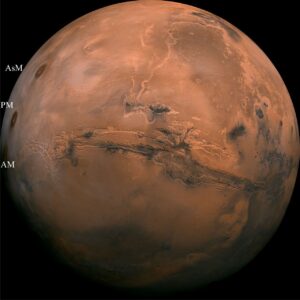
Venus
Runaway greenhouse conditions on Venus have produced an environment that is as inhospitable to rocks as it is to anything else. The planet is similar in size to Earth, but its axial rotation takes 243 Earth days, and a trip around the sun 225 days (a Venus day is longer than a Venus year!). Surface temperatures of 475o C, an early atmosphere of CO2 (current levels are 95.5% ) and SO2, and air pressures 92 times Earth’s (at sea level), mean that ‘weathering’ of rocks was (and remains) intense and rapid.
Tectonic activity in the form of extensional fractures and grabens is probably associated with volcanism and the rise of magma plumes (Mason et al., 2025).
These conditions in addition to active volcanism and tectonics means that resurfacing is also rapid. There are fewer than 1000 craters on Venus’ surface. The estimated average age of the surface is 500 to 150 million years. In other words, little if any of Venus’ older geological history is visible. Hence the long blank interval on the stratigraphic column.
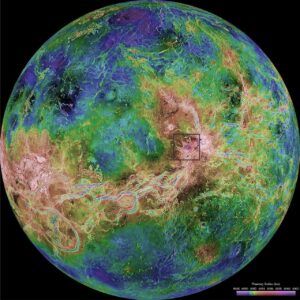
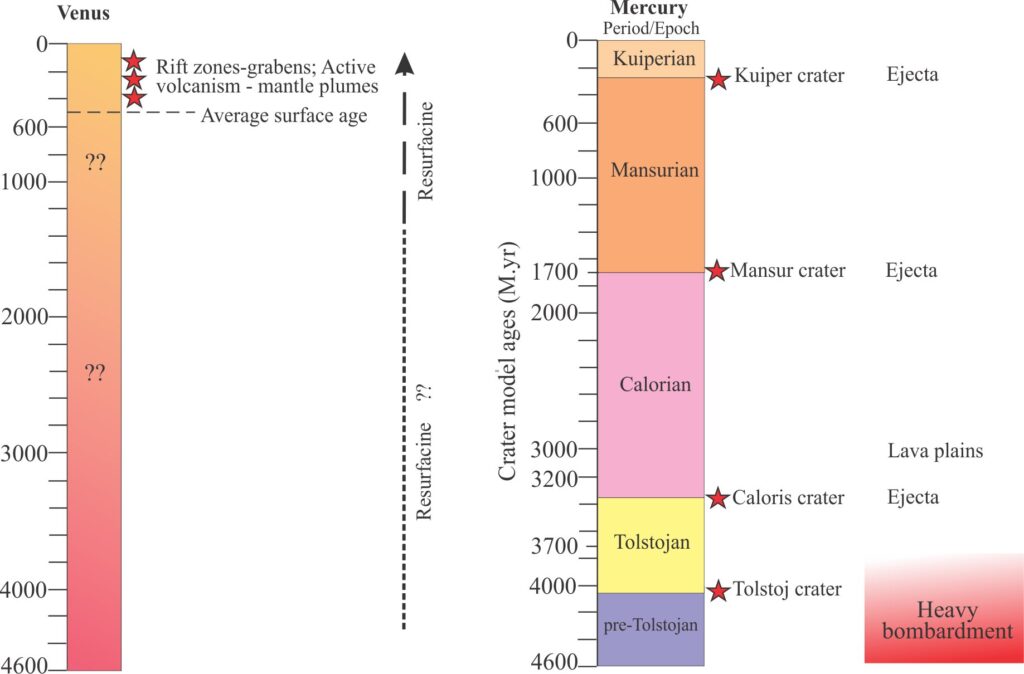
Mercury
The most recent data from Messenger Spacecraft has permitted reasonably detailed mapping of Mercury’s surface. Superficially Mercury resembles the Moon, where large tracts are saturated with craters. Crater density modeling indicates a similar impact history to the Moon. Mercury is slightly larger than the moon with a radius of 2440 km. Mercury’s atmosphere is too thin to promote any kind of resurfacing by weathering.
Much of Mercury’s surface is covered by lava flows. Like Earth and Mars, pre-Tolstojan differentiation of the crust probably included partial melting and effusive volcanism (Denevi et al., 2018). Gravity and magnetometer measurements indicate a dense core that is at least partly molten – core rotation provides a weak dynamo effect and a global magnetic field that is about 1% the strength of Earth’s field.
Like the lunar stratigraphy, the chronostratigraphic framework identifies four periods, the bases of which are defined by large impact structures. For example, the base of the Calorian Period/System is defined by one of the largest impact structures known – Caloris Planitia about 1550 km diameter. There is a reasonable correspondence between the Aitkenian-Nectarian-Imbrium periods on the Moon and the Tolstojan Period on Mercury.
Many of the older craters and basins are degraded by younger impacts and their ejecta, and lava flows. The depths of young impacts on the lavas provide estimates of lava thickness – 2.5 – 3.5 km.
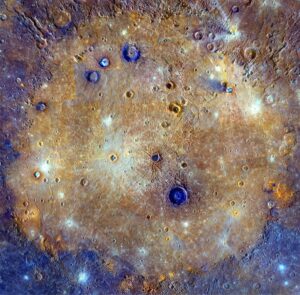
Other posts in this series
Martian Stratigraphy – The Framework
Evidence for sedimentary rocks on Mars
